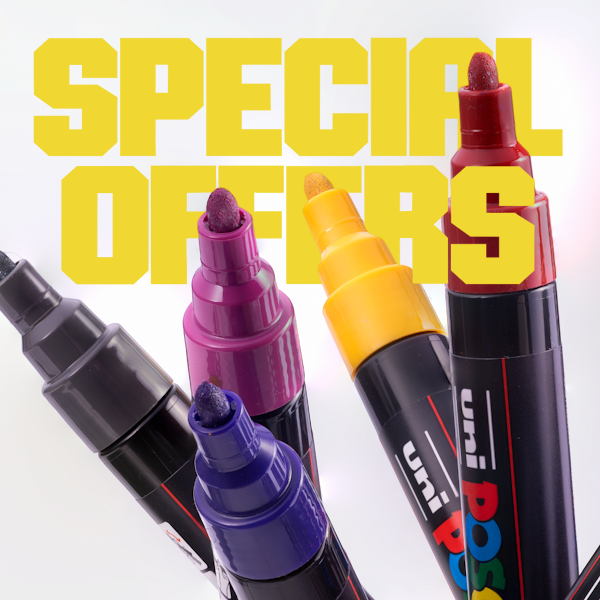If you love the process of stretching your own canvas before creating your masterpiece, we have a great range of canvas rolls to suit your needs. We stock primed and unprimed canvas rolls available in cotton and linen, made from high quality and tightly woven fibres, allowing you to stretch effortlessly and use with all media. For some artists, beginning a project with a canvas roll and going through the stretching process only enhances the sense of achievement upon completion of a work of art. View our range of canvas rolls today to get started!
What is a Canvas Roll?
If you are new to art and painting, you might not know what a Canvas roll is. Essentially, Canvas refers to the material, not the frame, meaning that a roll of canvas is simply the painting surface without the frame. Some artists prefer to stretch their canvas roll before they begin priming or painting, but others like to stretch the canvas afterwards - this is entirely up to you.
This method is often cheaper than buying a framed canvas or canvas board and you can be sure that it is stretched to suit your painting method and to a high standard, either by yourself or a professional canvas stretcher. Artist canvas roll is easier to transport than a framed canvas, so if you are constantly on the move it might be a good option for your lifestyle. Furthermore, if you are looking to create a custom-sized piece and cannot find a suitable existing Canvas Board, you might decide to stretch your own canvas.
How do you paint on an unstretched Canvas Roll?
Though the process before painting can be longer, many people prefer to create and prime their painting surface themselves. There are two main options: Either you can paint onto your unstretched canvas and then frame your painting afterwards, or you can stretch your own canvas using stretcher bars or pieces.
Unstretched can mean that you waste less time if you are likely to want to restart your painting like many perfectionist artists do. Here is a rough guide on using unstretched canvas:
-
Decide how large your painting will be. If you are not certain, make sure to cut larger, as you can always trim after you start painting. There will also be an edge, around ¼ of an inch, that will be hidden by a frame, so it’s important to leave this gap if you don’t want to lose any of your composition. You can mark this with a pencil line.
-
Cut out your canvas. For this, you can just use sharp scissors.
-
Support your canvas. When painting onto your unstretched canvas, you will need to secure it. Whether on a board, the wall or the floor, you can secure your canvas using tape or nails onto a sturdy surface so that it does not move while you are working on it. At this stage you can decide how much bounce you want your painting surface to have, which you can change by adjusting your clips or nails and also by changing the support - for example, a wall will create a more rigid surface than a board or Foam Board support.
-
Paint! Whether you prime first or paint onto a primed canvas roll, creating your masterpiece can take as much or as little time as you wish. For more information and advice on how to paint on canvas, check out our blog post.
-
Frame your masterpiece. This step involves glueing your canvas to a support, which can be Foamboard or another sturdy material. There should be as few air bubbles as possible during this step. You may even need to trim your support, which could involve using a saw. Then you can either frame your artwork yourself or take it to a professional framer. Beware that any canvas stretching that happens after the paint is dry may cause paint to crack or warp.
How do you stretch an Artist Canvas Roll?
The other option for using canvas roll is to stretch the canvas material first using Canvas Stretchers. This is a great option for people wanting a bespoke sized canvas, and the result is usually sturdier and better quality than most ready-made canvases on the market. You will, however, need a fair amount of equipment, tools and patience. Taking your roll to a professional is also an option, which might be expensive but will save you time and effort.
-
Get your tools. Typically, stretching a canvas requires a strong pair of scissors, a hammer, a heavy-duty staple gun, measuring tape, a rubber mallet, stretching pliers and a staple lifter.
-
Prepare your canvas stretcher. You will now need to arrange your two pairs of stretcher bars, using the mallet to knock them into place. It’s important that your diagonals are creating perfect 90° angles at the corners, so take care when measuring these.
-
Lay your canvas. Cover your work table or floor with a plastic sheet and then lay your canvas roll out, ensuring that if the canvas is pre-primed that the primed side is facing downwards. To create a professional-looking canvas, the weave of the material should be running parallel to the stretcher bar’s edges. Measure a difference of around 8cm away from the 4 corners and connect these marks with a long ruler to create a large rectangle around the frame. You can then neatly trim the excess outside this line.
-
Staple your canvas to the frame. This can get fiddly. First, fold one side of the canvas back over the frame’s edge. Grip the centre of that side with the stretching pliers and pull it tighter still, securing it with a staple in the centre of the frame. Repeat this process with the opposite side of the frame, then the other two sides. Holding up your canvas, you should see a diamond of tension where the staples are - if not, you need to stretch the canvas further, so you’ll need to re-do the staples.
-
More tension. Now that you have secured the 4 sides, you can begin tightening and stapling along the rest of the edges, working your way around to the corners. Work in a pattern to ensure it’s as central as possible. At the corners, the canvas should curl up in a lip shape to ensure that you can neatly fold the canvas at these points.
-
The corners. This step is a little like making a bed with a fitted sheet. Fold one side of the canvas’ corner into a neat triangle across the frame and staple it. Then, pull out the other side of the canvas into a square corner and fold this across the frame, stapling across this edge too.
-
Finishing touches. To ensure your canvas is as tight as you like it, you can hammer small wooden wedges into the corners of your stretcher bars. If the canvas is not yet primed, you can now prime your canvas so it is ready for you to start painting.
Which type of Canvas Roll is best?
Here at Cowling and Wilcox, we stock both cotton and linen canvas rolls. The material which you paint on is a wholly subjective decision, so you should experiment before deciding which to use for your masterpiece. Of course, there are advantages and disadvantages to each material.
-
Cotton: Cotton is typically more affordable than the other fabrics, which is a huge benefit for beginners or people dipping in and out of painting on canvas. Another advantage of cotton is its absorbency, making it great for holding your mediums. Cotton fibres are also hugely flexible, which is great if you stretch your own canvas, however this can also be a drawback. With large compositions, cotton might develop some slack in your frame. A good example of a canvas roll for beginners is our Cowling & Wilcox Cotton Duck Unprimed Canvas.
-
Linen: While more expensive, Linen can also come in a range of textures and weights to provide you with your desired finish. Due to the flax plant from which linen is made, there is also a more natural feel to linen as you might see some imperfections or variations in colours. All in all, linen canvas, such as the Cowling & Wilcox Linen Flax Canvas Roll, provides a more professional finish.
Do I need to prime a Canvas Roll?
In terms of priming, canvas roll should be treated in exactly the same way as a stretched canvas. You can purchase canvas that is already primed, such as the Cowling & Wilcox White Primed Cotton Canvas Roll, to save you time in your stretching process.
Alternatively, we offer plenty of unprimed canvas roll options which you can then prime to your own preferences. Primer, such as the White Gesso Primer from Daler-Rowney, can save you paint as it doesn't sink into the canvas fibres and also allow your art to last longer. If you’re looking for tips for how to prime your canvas, check out our blog.




















